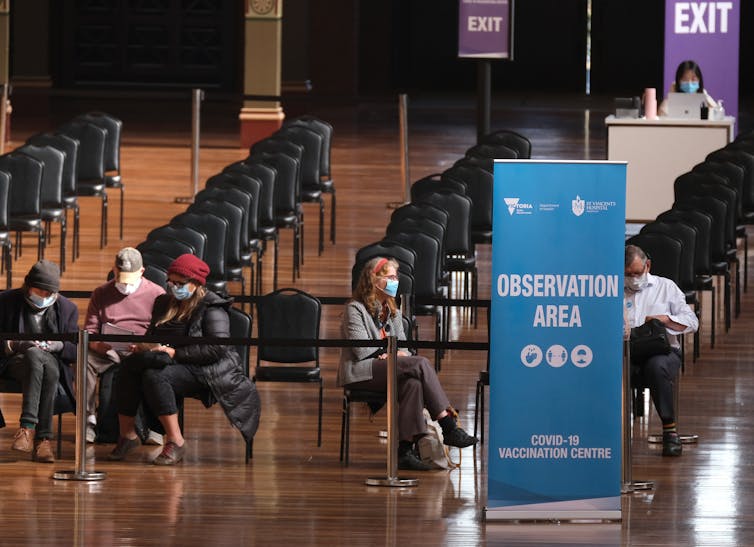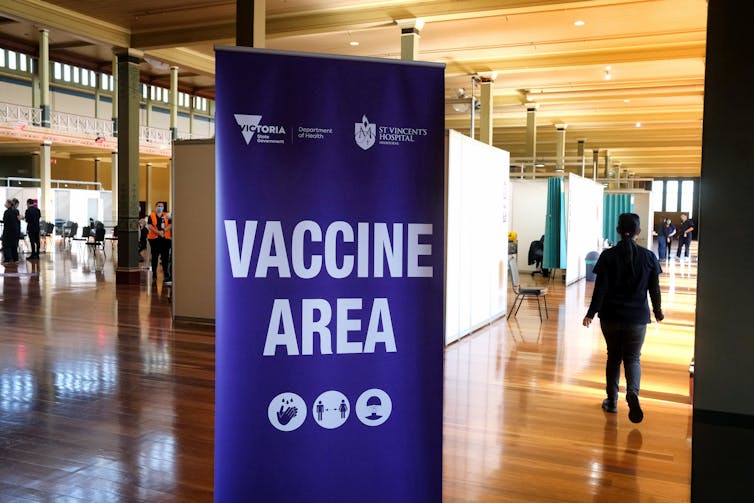Source: The Conversation (Au and NZ) – By C Raina MacIntyre, Professor of Global Biosecurity, NHMRC Principal Research Fellow, Head, Biosecurity Program, Kirby Institute, UNSW
News of four new positive cases of COVID-19 in Melbourne’s northern suburbs has prompted renewed discussion about the vaccine rollout.
The Victorian department of health is urging people to get tested if they have any symptoms at all, check in at venues and wear a mask on public transport. In a statement it said it is “regularly exploring options for new vaccination centre locations and has previously said that further locations will open.”
But if a person has been infected with coronavirus and is in an early stage of incubating the virus – would a vaccine confer any protection to that person?
The short answer is we don’t know yet for sure. But many vaccines do work in that way and when vaccine supplies are limited, targeting contacts for vaccination could be worth trying. This approach is sometimes called post-exposure prophylaxis, or PEP.
As I argued in The Lancet Infectious Diseases in March this year,many vaccines are effective as post-exposure prophylaxis (PEP), including those for measles, hepatitis A, and smallpox, and the long incubation period of SARS-CoV-2 means vaccines might work as PEP, and that we should be doing studies to test the effectiveness.
When vaccine supplies are limited, contact tracing and prophylactic use may be the most efficient use of limited doses.

Read more: COVID is surging in the world’s most vaccinated country. Why?
This approach has helped with other viruses
Many vaccines work to reduce infection and transmission in cases where people are vaccinated after they have been exposed to a virus (or become a contact).
However, the vaccine is sometimes less effective in this scenario than it would be if given to a person who has not been infected (also known as primary prevention).
In the case of smallpox, the vaccine was 95% effective for preventing primary infections but about half as effective in reducing disease among those who had already been exposed to the virus (and possibly in the early stages of infection).
In other words, the smallpox vaccine can be given to contacts of infected people and it will be half as effective as it would be if it was given to non-exposed people – but that is still effective enough.
In fact, contact tracing and vaccination of contacts became the mainstay of smallpox eradication in India, the last stronghold of smallpox.
With measles, vaccinating the contacts of positive cases is also highly effective in preventing further transmission.
This approach is more likely to work with diseases that have a longer incubation period — and SARS-CoV-2 (the virus that causes COVID-19) is one that does.
Australia is in a good position to study this, as we are not dealing with a large burden of COVID-19 on our health system. Outbreaks prior to vaccine availability could be compared to outbreaks where contacts are vaccinated.
This can even inform an approach whereby we vaccinate returning Australians before they board a plane to come home.

Mass vaccination – and getting the space between doses right
In the end, the best protection is mass vaccination and ensuring as many people as possible are fully vaccinated as quickly as possible. For speed, the spacing between doses matters because the longer it takes to be fully vaccinated, the more vulnerable we are during outbreaks.
The United Kingdom is seeing a surge of cases linked to the B16172 variant. One recent study found being partially vaccinated was only 33% protective against symptomatic disease with B16172 three weeks after the first dose. The protection went up to over 60% for AstraZeneca and 80% for Pfizer after two doses.
Unlike the US, where people got doses of a mRNA vaccine within three weeks or the one-dose Janssen vaccine, the UK chose to space vaccine doses (for both Pfizer and AstraZeneca) by three months. That is a long time during a pandemic.
Despite both countries making a flying start with a high proportion of people who received one dose, the proportion of fully vaccinated people is much lower in the UK than the US.
In Australia, the Pfizer vaccine is given with a three week gap between doses but there is a 12 week gap between doses for the AstraZeneca vaccine to ensure best protection. Like the UK, Australia could also look for ways to reduce the time between doses for the AstraZeneca vaccine, but there would be a trade off with reduced efficacy.
A 12 week gap between doses of AstraZeneca is for best individual protection, which is fine while we do not have sustained community transmission. But this leaves us vulnerable if an outbreak takes off (especially if caused by a variant of concern). In the UK, they are moving to offer the second dose of the AstraZeneca vaccine at eight weeks to reduce the time between doses and speed up full vaccination.
Australia would be best protected with a higher proportion of the population fully vaccinated as soon as possible.
Read more: I’m over 50 and hesitant about the AstraZeneca COVID vaccine. Should I wait for Pfizer?
– ref. Four cases in Melbourne’s north as vaccine push rolls on but what if I’ve already been recently exposed? – https://theconversation.com/four-cases-in-melbournes-north-as-vaccine-push-rolls-on-but-what-if-ive-already-been-recently-exposed-161417







